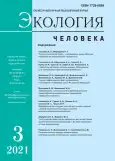PREVALENCE OF SMOKING AND HAZARDOUS DRINKING AMONG INDUSTRIAL WORKERS IN THE SVERDLOVSK REGION
- 作者: Maksimov D.M.1,2, Maksimova Z.V.1,2
-
隶属关系:
- Ural State Medical University
- Regional Center of Public Health and Medical Prophylaxis
- 期: 卷 28, 编号 3 (2021)
- 页面: 34-41
- 栏目: Articles
- URL: https://journals.rcsi.science/1728-0869/article/view/64422
- DOI: https://doi.org/10.33396/1728-0869-2021-3-34-41
- ID: 64422
如何引用文章
全文:
详细
作者简介
D. Maksimov
Ural State Medical University; Regional Center of Public Health and Medical Prophylaxis
Email: kafsemmed@gmail.com
кандидат медицинских наук, доцент кафедры профилактической, семейной и эстетической медицины ФГБОУ ВО «Уральский государственный медицинский университет» Минздрава России; врач отдела мониторинга факторов риска неинфекционных заболеваний ГАУЗ CO «Свердловский областной центр общественного здоровья и медицинской профилактики» Yekaterinburg, Russia
Zh. Maksimova
Ural State Medical University; Regional Center of Public Health and Medical ProphylaxisYekaterinburg, Russia
参考
- Баланова Ю. А., Имаева А. Э., Концевая А. В., Шальнова С. А., Деев А. Д., Капустина А. В., Евстифеева С. Е., Муромцева Г. А. Эпидемиологический мониторинг факторов риска хронических неинфекционных заболеваний в практическом здравоохранении на региональном уровне: методические рекомендации ФГБУ «ГНИЦПМ» Минздрава России / под ред. С. А. Бойцова. М.: Медиа Сфера, 2016. 111 с
- Баланова Ю. А., Концевая А. В., Шальнова С. А. и др. Распространенность поведенческих факторов риска сердечно-сосудистых заболеваний в российской популяции по результатам исследования ЭССЭ // Профилактическая медицина. 2014. № 18 (5). С. 42-52
- Бондаренко Н. В., Гохберг Л. М., Ковалева Н. В. и др. Образование в цифрах: 2019: краткий статистический сборник / Нац. исслед. ун-т «Высшая школа экономики». М.: НИУ ВШЭ, 2019. 96 с
- Глобальный опрос взрослого населения о потреблении табака: Российская Федерация. Краткий обзор, 2016 г. Копенгаген: Европейское региональное бюро ВОЗ, 2016, 9 p
- Глобальный опрос взрослого населения о потреблении табака. Российская Федерация, 2009. Страновой отчет. ВОЗ / Министерство здравоохранения и социального развития Российской Федерации, 2009. 185 с
- Кардиоваскулярная профилактика. Национальные рекомендации. Всероссийское научное общество кардиологов // Кардиоваскулярная терапия и профилактика. 2011. № 10 (6), пр. 2. 64 с
- Концевая А. В., Шальнова С. А., Баланова Ю. А. и др. Социально-экономические градиенты поведенческих факторов риска в российской популяции (по результатам исследования ЭССЕ-РФ) // Кардиоваскулярная терапия и профилактика. 2015. № 14 (4). C. 59-67
- Численность населения Российской Федерации по полу и возрасту на 1 января 2015 года: (стати-стический бюллетень). Федер. служба гос. статистики (РОССТАТ). М.: Росстат, 2015. 388 с.
- Babor T. F., Higgins-Biddle J. C. Brief intervention for hazardous and harmful drinking: a manual for use in primary care. Geneva, World Health Organization, 2001, 53 p.
- Cohen A. K., Syme S. L. Education: a missed opportunity for public health intervention. American journal of public health. 2013, 103 (6), pp. 997-1001.
- Cutler D. M., Lleras-Muney A. Education and Health: Evaluating Theories and Evidence. National bureau of economic research. Working Paper No. 12352, 2006, 37 p.
- Droomers M., Schrijvers C. T., Mackenbach J. P. Educational Differences in Starting Excessive Alcohol Consumption: Explanations from the Longitudinal Globe Study. Soc Sci Med. 2004, 58 (10), pp. 2023-2033.
- Feinstein L., Sabates R., Anderson T. M., Sorhaindo A., Hammond C. What are the effects of education on health. Proceedings of the Copenhagen Symposium, 2006, 354 p.
- GBD 2016 Russia Collaborators. The burden of disease in Russia from 1980 to 2016: a systematic analysis for the Global Burden of Disease Study 2016. Lancet. 2018, 392 (10153), pp. 1 138-1146.
- Global status report on alcohol and health 2018. Geneva, World Health Organization, 2018, 450 р.
- Henkel D. Unemployment and substance use: a review of the literature (1990-2010). Curr Drug Abuse Rev. 2011, 4 (1), pp. 4-27.
- Munafo M. R., Tilling K., Ben-Shlomo Y. Smoking status and body mass index: a longitudinal study. Nicotine Tob Res. 2009, 1 1 (6), pp. 765-771.
- Murakami K., Hashimoto H. Associations of education and income with heavy drinking and problem drinking among men: evidence from a population-based study in Japan. BMC Public Health. 2019, 19 (1), 420, pp. 1-9.
- National Center for Health Statistics. Health, United States, 2011: With Special Feature on Socioeconomic Status and Health. Hyattsville, MD, 2012, 556 p.
- Noncommunicable diseases country profiles 2014. Geneva, World Health Organization, 2014, 210 p.
- Obesity: preventing and managing the global epidemic. Report of a WHO consultation. World Health Organ Tech Rep Ser. Geneva, World Health Organization, 2000, 252 p.
- OpenEpi (2013) Open Source Epidemiologic Statistics for Public Health, Version 3.01. https://www.OpenEpi.com.
- Palipudi K. M., Morton J., Hsia J., Andes L., Asma S., Talley B., Caixeta R. D., Fouad H., Khoury R. N., Ramanandraibe N., Rarick J., Sinha D. N., Pujari S., Tursan d’Espaignet E. On behalf of the GATS Collaborative Group. Methodology of the Global Adult Tobacco Survey - 2008-2010. Glob Health Promot. 2016, 2 spl., pp. 3-23.
- Sayon-Orea C., Martinez-Gonzalez M. A., Bes-Rastrollo M. Alcohol consumption and body weight: a systematic review. Nutr Rev. 201 1, 69 (8), pp. 419-431.
- Syamlal G., Mazurek J. M., Dube S. R. Gender differences in smoking among U.S. working adults. Am J Prev Med. 2014, 47 (4), pp. 467-475.
- The Jamovi project (2020). Jamovi (Version 1.2). Retrieved from https://www.jamovi.org.
- WHO report on the global tobacco epidemic, 2017: monitoring tobacco use and prevention policies. Geneva, World Health Organization, 2017, 263 p.
补充文件







